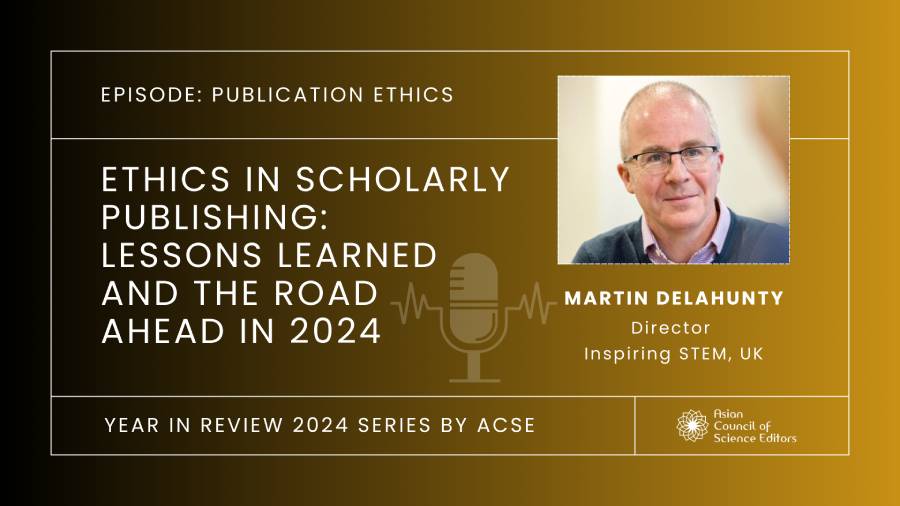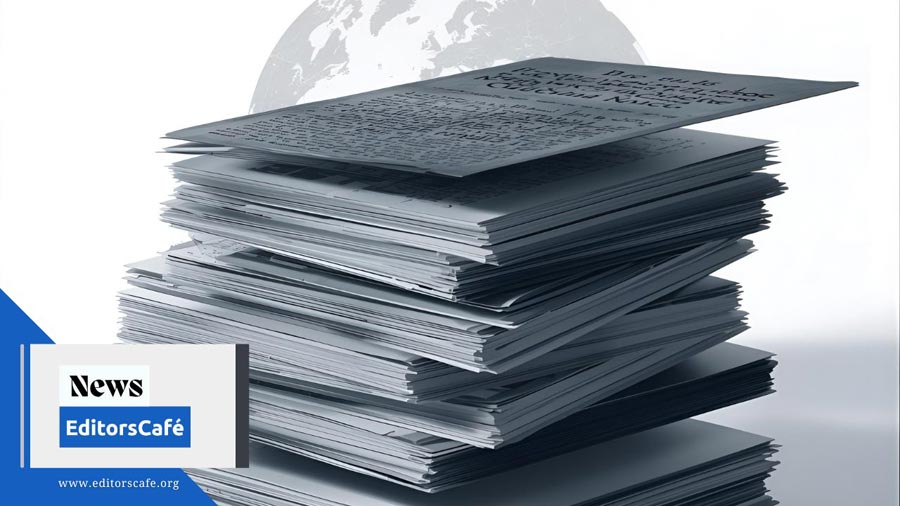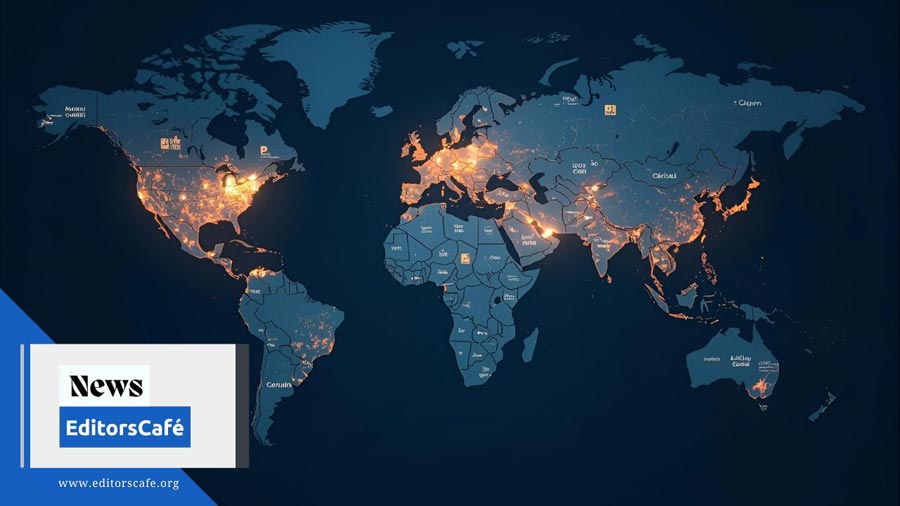Ethics in Scholarly Publishing: Lessons Learned and the Road Ahead with Martin Delahunty

The Year in Review series by the Asian Council of Science Editors (ACSE) has provided a platform for reflecting on the key developments that shaped scholarly publishing in 2024. Among these, research ethics remains a cornerstone of academic integrity, with ongoing challenges such as transparency, responsible authorship, and peer review ethics demanding continued attention.
As ACSE concludes this insightful series, we are pleased to feature a final conversation with Martin Delahunty, Managing Director of Inspiring STEM Consulting and a respected leader in scholarly publishing. With a distinguished career spanning global STM publishing, open access strategies, and research integrity advocacy, Martin has been a strong voice in upholding ethical standards.
In this interview, he shares his reflections on the lessons learned in 2024 and offers his perspective on the path forward for ethical scholarly publishing in 2025.
Q1: Ethical publishing forms the backbone of scholarly communication. As we reflect on 2024, how would you characterize the overall state of ethics in scholarly publishing? Are we making meaningful progress, or do the challenges continue to outweigh the solutions?
Through 2024, ethics in scholarly publishing continued to be severely challenged. We saw large numbers of retracted papers with 4,255 notices of retraction registered on the Retraction Watch database and a total of 56 journals were delisted from Clarivate's Web of Science indexing because they failed to maintain a standard of quality, did not comply with ethical standards, or otherwise did not meet the criteria determined by the Web of Science Editors.
On top of this, the rapid adoption of generative AI and its wide accessibility is seen as a new problem but in reality, it simply pours fuel onto existing fires smouldering across the publishing landscape. I don't believe that it creates new ethical challenges but merely amplifies pre-existing problems with authorship attribution, content authenticity, and transparency in manuscript preparation and peer review.
Despite this, I remain hopeful, and I can see that meaningful progress is being made on the publishers' side. A first step is to admit to mistakes and become more transparent about the challenges and then move promptly to action change.
The STM Association's Research Integrity Hub has grown and evolved over the past two years with 35 supporting associations and over 100 participants in cross-publisher working groups. There are innovative technology start-ups like Clear Skies addressing the problems with papermills, and existing editorial workflow providers such as Morressier, focusing on research integrity.
All publishers and journal editors must increase their focus on research integrity by placing greater emphasis on detecting and preventing research misconduct, implementing more robust screening processes and ethical guidelines.
But solutions will continue to be ultimately ineffective until we address the root cause of unethical and fraudulent publication practices – that is, the underling pressure on academic researchers to publish and motivations to undertake unethical and fraudulent practices.
The UK Committee on Research Integrity published their 2024 statement concluding that one of the ways in which organisations can uphold and enhance research integrity is by thinking about how they assess researchers for recruitment, promotion and funding. To uphold and enhance research integrity, changes could be made in the incentive and rewards system that UK research depends upon.
Q2: What strategies have proven most effective in combating predatory journals, and how can publishers, researchers, and institutions collaborate to safeguard academic integrity?
Education and awareness are important. Predatory journals do not adhere to industry standard ethical practices but instead exploit the paid-for open access publishing model to generate revenue. These journals intentionally misrepresent practices of editorial and peer review, methods of journal operation, article process charging, dissemination, indexing, and archiving.
Publishers and journal editors must be ever more involved in training, especially early-career researchers, to identify predatory journals through clear warning signs like aggressive solicitation emails, rapid acceptance promises, and minimal peer review.
Cross-publisher initiatives such as 'Think.Check.Submit' and organizations such as the Committee on Publication Ethics (COPE), the International Committee of Medical Journal Editors (ICMJE), have greatly helped researchers in a very practical way to identify trusted journals and publishers for their research.
We have seen also an increasing number of conferences, events and workshops addressing the problem, such as those convened by the Asian Council of Science Editors make invaluable contributions.
However, academic and research institutions need to play a bigger role. There is a need for more robust and comprehensive institutional ethics and research integrity guidelines. Developing clear institutional policies on approved publication venues and providing resources will help researchers verify legitimate journals.
I would like to see more serious moves to developing collaborative verification systems for authors, institutions, and published content. That can be through upgrading established journal evaluation tools and databases that help identify reputable publications through transparent criteria.
We can only achieve success in combating predatory publishing though ongoing vigilance and coordination between all parties in the scholarly communication ecosystem.
Q3: How has the publishing industry addressed plagiarism challenges amplified by the use of AI tools, and what additional measures are necessary to ensure ethical authorship practices?
Perhaps too little and too late but, the publishing industry has taken several steps to address plagiarism challenges amplified using AI tools. This includes checking for accuracy and freedom from plagiarism.
Additionally, most publishers now have detailed guidelines on plagiarism, and they screen submissions using software like iThenticate's CrossRef Similarity Check to flag manuscripts with high similarity to published works.
The Committee on Publication Ethics has also issued a position statement indicating that AI tools cannot be listed as authors of a paper. Authors are fully responsible for the content of their manuscript, even those parts produced by AI, and are liable for any breach of publication ethics.
To ensure ethical authorship practices when using AI tools, additional measures are necessary. Most important is maintaining human oversight and supervision to verify AI-generated content and ensure it meets academic standards and ethical guidelines.
We need to ensure that when authors and publishers use AI tools to enhance original content, proper paraphrasing and citation are employed to avoid plagiarism and give credit to the original authors.
The majority of large language models remain opaque in explaining and verifying the sources of content used for training. We need full trust, transparency and openness to successfully deploy AI tools and gain benefit.
And I said before, education and training are most important to ensure authors, reviewers, and editors understand the ethical use of AI tools.
Q4: What are the key ethical concerns associated with open access and open science, and how can publishers balance the benefits of openness with the responsibility of maintaining ethical standards?
I don’t see ethical concerns associated with the principles of open access and open science but only with their misuse in the context of publishing fees and now use to train large language models. We should avoid the risk of conflating both with fraudulent and unethical practices.
Publishers can balance the benefits of openness with the ethical responsibility of reducing or removing significant financial barriers for authors to publish open research content and open data. Whether open access or behind a subscription firewall, ethical standards can be maintained by ensuring stringent peer review and validation and accreditation of published content.
Every few years we come back to discussing the pros and cons of open peer review but it remains an exception rather than the rule. Perhaps the advent of AI will increase the effectiveness of open peer review whilst also addressing the concerns, for example, protecting reviewer anonymity when needed.
The new challenge is to ensure that AI companies adhere to clear ethical policies and standards with respect to using open content and data sharing and protecting author and publisher copyright. These companies need to demonstrate much more transparency and disclosure of potential conflicts of interest, funding sources, and any other relevant information.
We should not forget that open science principles are about promoting fairness and equity in the sharing and resharing of academic work and research. Publishers and AI companies must continue to ensure diversity, equity, and inclusion in research and publication practices.
Q5: How can publishers leverage technology more effectively to address ethical challenges, such as identifying misconduct or ensuring transparency, without creating new risks?
Publishers can leverage technology more effectively to address ethical challenges by implementing various tools and systems. For instance, they can utilize AI and machine learning algorithms to detect plagiarism and identify potential misconduct in manuscripts.
Additionally, publishers can use technology to promote transparency, such as by using open peer-review systems, where reviewers’ comments and identities are made public, or by providing detailed information about the publication process and editorial decisions.
Perhaps also, blockchain technology can be used to create a transparent and tamper-proof record of the publication process, from manuscript submission to final publication. However, it is essential for publishers to carefully consider the potential risks and challenges associated with leveraging technology, such as ensuring the security and integrity of the data and systems used and addressing potential biases in AI algorithms.
Overall, publishers must strike a balance between leveraging technology to address ethical challenges and minimizing the risks associated with its use. This can be achieved by investing in the development of robust and secure systems, providing training and support for editors and reviewers, and establishing clear guidelines and protocols for the use of technology in the publication process.
Q6: What guidelines or best practices would you recommend to ensure the responsible and ethical use of AI in scholarly publishing workflows?
The first principle in my opinion is to prioritize transparency and responsible AI practices, especially avoiding bias and lack of diversity, when evaluating and selecting AI tools for publishing. We need to understand fully how these models work before we can gain the trust of all stakeholders in the scholarly publishing ecosystem.
In a very positive light, we already see publishers and researchers establishing collaborative working groups to facilitate knowledge-sharing and the development of guidelines and standards for AI use in publishing. This can extend to organizations foster collaboration across all disciplines, engaging experts from policy, technology, ethics, and social advocacy to ensure multifaceted perspectives and address potential ethical concerns comprehensively.
Journal guidelines are already requiring authors to disclose the use of any generative AI tools in the research process for the generation of any content but publishers can do more to promote AI literacy and education through workshops, training programs, and resources.
Publishers are now testing AI tools in editorial workflows but it is necessary to conduct empirical trials and case studies to evaluate their effectiveness. Sharing the findings with the publishing community will foster transparency and facilitate better informed decision-making.
Best practices need to be developed around the responsible use of data and to ensure the privacy and security of data used in AI tools. This includes obtaining proper consent, protecting privacy, and complying with relevant regulations. Any sensitive or confidential data should be deleted from the AI tool’s memory after use.
What remains critical for responsible and ethical sue of AI in scholarly publishing is to maintain human-cantered design and oversight. This will include understanding the limitations of datasets and models, building fairness, interpretability, privacy, and safety into the systems, and conducting ongoing assessments and testing.
Q7: Looking ahead to 2025 and beyond, what would you consider the most critical steps the publishing community must take to build a more robust ethical framework and ensure lasting integrity in scholarly communication? To build a more robust ethical framework and ensure lasting integrity in scholarly communication, the publishing community must take several critical steps in 2025 and beyond.
While meaningful progress is being made in developing ethical frameworks and tools, the publishing landscape faces new challenges, particularly with emerging technologies and increasing pressure to publish. The key to progress lies in continued collaboration between publishers, editors, researchers, and academic institutions to implement and enforce ethical standards.
While technology can aid in maintaining research integrity and countering plagiarism, data manipulation, and other forms of research misconduct in publications, there is not enough focus on the underlying culture and motivations in academia. Deeply embedded cultural differences can significantly impact research integrity and cultural norms can also affect how ethical issues are perceived and handled. I don’t believe that publishers truly understand the problem and have not done enough to support solutions.
Therefore, I will finish by just saying that I would like to see publishers and editors working more closely with academic and research institutions to properly address the age-old publish-or-perish mentality. We can do so much better.
Martin's insights into the evolving ethical landscape of publishing highlight both the progress made and the challenges that remain. His perspectives provide a valuable starting point for researchers, editors, and institutions committed to responsible publishing practices. We thank Martin for his contributions to this important discussion and look forward to continuing the conversation within the ACSE community.
Keywords
Research Integrity Peer Review Ethics Predatory Publishing AI in Scholarly Publishing Open Science Plagiarism Detection Ethical AuthorshipDisclaimer
The views and opinions expressed in this article are those of the author(s) and do not necessarily reflect the official policy or position of their affiliated institutions, the Asian Council of Science Editors (ACSE), or the Editor’s Café editorial team.



